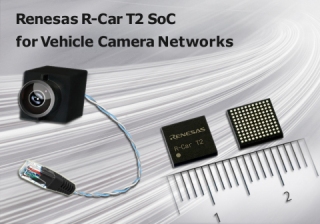Sep 10 2015
Renesas Electronics Corporation, a premier supplier of advanced semiconductor solutions, today announced the development of the R-Car T2 system-on-a-chip (SoC), an SoC dedicated for Ethernet AVB-enabled vehicle camera networks, complementing the company’s popular R-Car Family devices for infotainment, instrument cluster and ADAS (Advanced Driver Assistance System) applications.
 Renesas R-Car T2 SoC for vehicle camera networks (Graphic: Business Wire)
Renesas R-Car T2 SoC for vehicle camera networks (Graphic: Business Wire)
The new R-Car T2 enables the delivery of high-resolution camera video through multiple systems while maintaining real-time performance with low latency levels. These capabilities are key to providing the “surround view” monitoring and obstacle detection applications that contribute to safe driving experiences.
Initially used for rear-view functionality and parking assistance applications, the use of vehicle cameras has since expanded to support 360-degree “surround view” functionality that expands what is seen by the system to every direction around the vehicle, helping to improve driver safety. To further optimize safety, vehicle camera video is also now being used in driver assist systems for braking, steering and providing obstacle detection warnings, for instance when changing lanes. These sophisticated systems demand substantially higher processing performance in order to handle the expanded range of image recognition targets and increased processing load imposed by multiple cameras with higher pixel counts. Ethernet AVB offers features such as guaranteed bandwidth and synchronization of multiple cameras simultaneously, and a system involving additional cameras that can be flexibly upgraded. Moving forward, Ethernet AVB is expected to become the mainstream technology for automotive high-speed networking.
The R-Car T2 supports multiple standards (Note 1), including IEEE 802.1AS, IEEE802.1Qav, IEEE802.1Qat, and IEEE1722 standards. The R-Car T2 SoC features a built-in H.264 encoder developed exclusively by Renesas to provide low-latency compression while maintaining real-time high-quality HD video (1,280 × 960) transfer. Video can be compressed with extremely low latency of less than 1 msec (one-thousandth of a second) and delivered to multiple systems through the networks to vehicle systems. The high quality and real-time transfer create a high level of safety, making it possible to rapidly share camera footage with the advanced driver assist systems.
Previously, with the popularity of Ethernet as an easy-to-use network standard that allows video to be transferred to multiple systems, video compression was necessary as the maximum bandwidth supported by UTP cable (Note 2) is 100 Mbps, and latency was an issue in applications such as driver safety assist systems. Now Renesas has succeeded in reducing the latency time to less than 1 msec, which is equivalent to a movement distance of 2.8 cm when driving at 100 km/h. This enables nearly real-time data transfer, allowing use in driver safety assist systems and making it possible to switch from the current LVDS system to Ethernet. In addition, convenient network support makes it possible to connect multi-display functionality and the building of advanced vehicle information systems that provide superior safety and comfort.
Key features of the R-Car T2 SoC:
(1) Compliant with four Ethernet AVB standards for enabling vehicle camera video sharing among multiple displays
Previously, in camera systems adopting analog or LVDS signal transfer, the video processing was concentrated peer-to-peer in a single processing device such as a navigation system or a meter cluster. With Ethernet AVB, however, video signals from multiple cameras can be distributed in parallel to multiple processing devices. This means that video from the cameras can be utilized by multiple displays and driver assist systems, among others. It also enables the camera networks to be configured flexibly for different vehicle grades or option packages, for example, by increasing the number of cameras or adding displays.
Additionally, the Ethernet AVB standard also supports the use of Power over Ethernet (PoE), in which power is supplied over transmission lines. This reduces or eliminates the need for separate power supplies or dedicated cables for individual modules.
(2) Low-latency transfer of high-quality HD video that contributes to increasing the value of the car by video recognition
Developed exclusively by Renesas, the built-in ultra-low-latency H.264 encoder has adopted the Ethernet AVB standard with excellent real-time transfer of digital HD signals. The improved camera quality enhances visibility and aids in driver oversight prevention, for example, while the real-time performance better meets the safety requirements for driver assist systems that detect pedestrians and obstacles.
(3) Ultra-low power consumption and small-size form factor for more power-efficient and compact camera modules
The R-Car T2 features power consumption as low as 40 mW (typ.), which reduces heat concerns for a sealed camera module designed to keep out moisture and dust. In addition, at 6 mm square in size, the small form factor fits in camera modules designed to take up minimal space and contributes to flexible design.
Availability
Samples of the R-Car T2 SoC are available now. Mass production of the R-Car T2 is scheduled to begin in December 2016 and is expected to reach a volume of 500,000 units per month by September 2017. (Availability is subject to change without notice.)
For more information on Renesas, follow Renesas Electronics America at @RenesasAmerica on Twitter and https://www.facebook.com/RenesasAmerica.
(Note 1) IEEE802.1Qat: function for bandwidth reservation (ensures a constant bandwidth to the receiving side from the transmitting side)
· IEEE 802.1AS: Time synchronization function (function aimed at synchronizing the entire system within 1 ms)
· IEEE802.1Qav: traffic shaping function (function that smooths traffic to make sure that the priority packet does not exceed the bandwidth)
· IEEE1722: the Ethernet AV-Transport standard (provision of data Packet Format of Audio / Video)
(Note 2) UTP Cable: Unshield Twisted Pair Cable